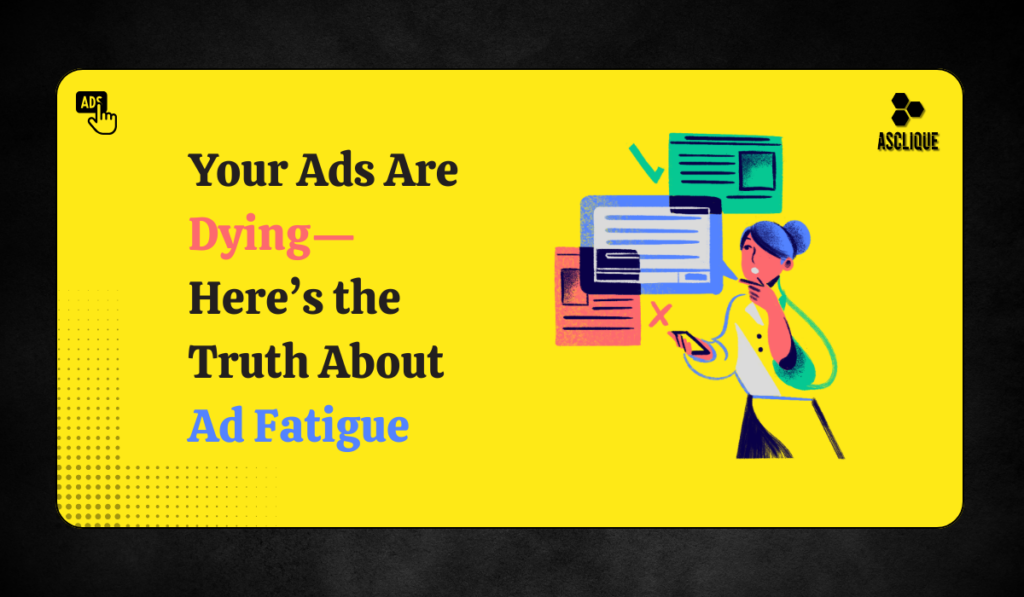In the fast-paced digital world of today, attention is transient, and competition is cutthroat. Individuals are constantly bombarded with ads—on social media platforms, search engines, websites, and apps. When individuals are exposed to the same message over and over again, they simply become disinterested. That’s where ad fatigue in digital marketing comes into play.
Ad fatigue doesn’t just damage engagement—it damages your return on investment (ROI) for ads specifically. Regardless of how good an ad was performing when it initially launched, displaying it too many times to the same audience will ultimately result in declining performance.
This piece defines ad fatigue as a phenomenon, why it occurs, how it can be recognized, and a few of the ways through which you can evade it so that your campaigns function at their best.
What is Ad Fatigue in Digital Marketing?
Ad fatigue refers to the reduction in ad effectiveness because of excess exposure. Since users get too familiar with viewing an ad an excessive number of times, it begins to become ignored—or in some cases, annoying. You’ll notice fewer interactions, lesser clicks, and increasing costs.
It’s comparable to listening repeatedly to the same song. Whether you liked it initially, shortly enough, you’re not that interested anymore.
In online advertising, this fatigue hits quickly—particularly on channels like Facebook, Instagram, and YouTube where ads are visual and frequency is high.
Why Does Ad Fatigue Happen?
Ad fatigue does not occur by chance. It occurs due to ineffective ad management or the “set it and forget it” approach. Let’s examine the primary culprits:
- Too much repetition: If people view your ad 10 times in a week, they will tune out.
- No variety: Recycling the same image, copy, or call-to-action across various platforms and campaigns.
- Narrow audience targeting: Limited audiences are continuously shown the same ads.
- No frequency caps: Some advertisers fail to cap how many times the same user views their ad.
- Keeping campaigns active for too long with no refreshes: Even effective ads eventually become fatigued.
Research from Social Media Today shows that Facebook ad engagement drops by up to 70% when the same creative is shown more than 6 times.
Signs You’re Facing Ad Fatigue in Digital Campaigns
Ad fatigue can sneak up on you. Here are warning signs to watch for:
- Decreasing Click-Through Rate (CTR) – Your ad is still being shown, but people aren’t clicking.
- Rising Cost-Per-Click (CPC) – You’re paying more but getting less.
- Fewer conversions – Whether sales, sign-ups, or downloads, your conversions decline.
- Increased bounce rate – Visitors come to your landing page but bounce off right away.
- Fewer social ad interactions – Less likes, comments, and shares.
Should several signals emerge simultaneously, stop, audit, and relaunch your ads.
The Impact of Ad Fatigue on Marketing ROI
The effect of ad fatigue on internet advertising is more than subpar performance. It may hit your brand, budget, and long-term strategy.
Here’s why:
- Budget waste: Your ad is running, but it’s not delivering.
- Brand distrust: Overexposure can make people despise your brand.
- Blindness to the audience: People may cease to notice your brand altogether.
- Shorter ad life: Great campaigns can burn out fast if they’re not handled properly.
Research conducted by AdRoll identified that companies which experienced ad fatigue saw their return on ad spend (ROAS) go down by as much as 30% in a few cases.
Strategies to Prevent Ad Fatigue in Digital Marketing
It is easy not to commit ad fatigue–one just has to put some imagination and thinking behind it. How to refresh and keep campaigns innovative:
- Rotate Creatives Periodically: Do not use one ad alone. Develop a series of versions with dissimilar visuals, copy, or format and rotate them 10–14 days.
- Extend Your Target Audience: Extend your audience to prevent overexposure to a small subset. Try new audience segments or use lookalike audiences on social media.
- Use Frequency Caps: Place caps on how many times the same user views your ad. Ad platforms such as Google Ads and Facebook Ads Manager enable you to cap ad frequency.
- Test Various Ad Formats: If you have only been using static images, experiment with video, carousels, or GIFs. These can significantly boost user engagement.
- Seasonal and Timely Refreshes: Refresh your ads based on seasons, festivals, or current trends. It indicates your brand is current and responsive.
- Personalize Your Message: Segment your message to suit various segments. A one-size-fits-all approach ad gets tired soon.
Best Practices to Refresh Your Ad Creatives
Revamping doesn’t necessarily imply complete redesigning. Little tweaks can work wonders.
- Apply new images or colors to redirect attention.
- Overhaul the CTA – Use other action words instead of “Sign Up Now” such as “Try for Free.”
- Hilight alternate benefits – Switch between alternating focus on price, speed, quality, etc.
- Use reviews or testimonials – Real people’s feedback builds trust and variety.
- Use user-generated content – More authentic and more human.
Don’t forget to test which ones perform better. Build on success.
Tools to Monitor and Manage Ad Fatigue
It is important to keep an eye on performance indicators. Use these tools to monitor and control ad fatigue:
- Meta Ads Manager (Facebook/Instagram) – Monitor frequency, engagement, and relevance score.
- Google Ads – Make use of frequency reports and performance reports.
- AdEspresso – Keep an eye on ad fatigue trends in Facebook Ads.
By using the correct tools, you can outwit fatigue before it kills your campaign.
Conclusion
Ad fatigue in digital marketing is a legitimate concern about campaign success. But it’s not a problem that can’t be solved. With a pro-active strategy—creative rotation, message refresh, monitoring your metrics—you can prevent burnout and get people excited.
Imagine your audience as an actual person (they are). Would you enjoy seeing the same advertisement 10 times within a single day? Doubt it. By paying attention to your audience’s attention, your performance is better.
Consistency is king, but repetition that is irrelevant can hurt more than assist. Shake it up, get to the point, and re-energize—your campaign will be grateful.
FAQ’s
How often should I change my ads to prevent fatigue?
Try to rotate your ads every 10–14 days by performance. Monitor metrics such as CTR and frequency to determine.
Can ad fatigue affect brand reputation?
Yes. Saturation can make users annoyed and even turn them against your brand.
Do different platforms experience ad fatigue differently?
Yes. Social media websites are more fatigued than search websites because the visual repetition is what the user sees.
Is it enough to just change images to beat ad fatigue?
Not always. Shifting visuals works, but changing your message, offer, and targeting matters as well.

